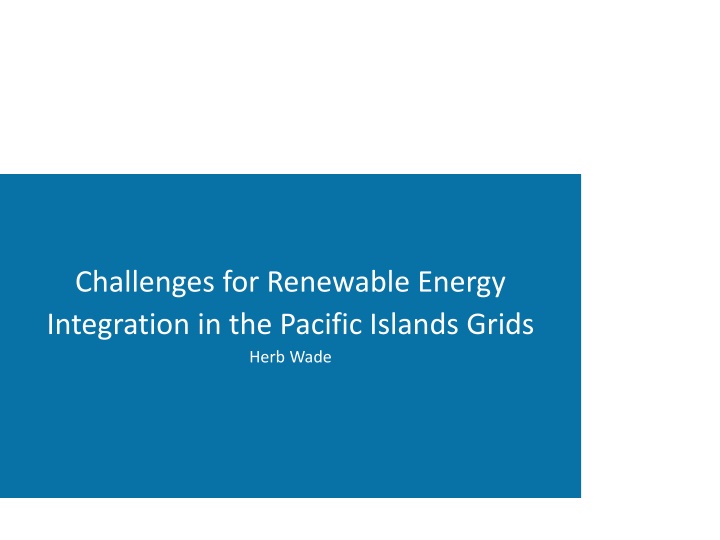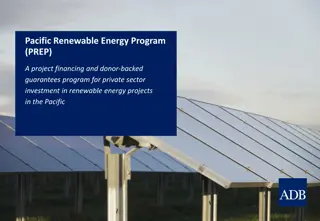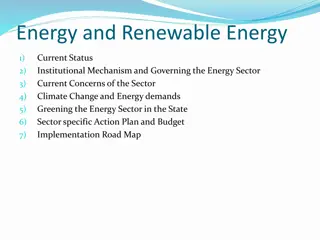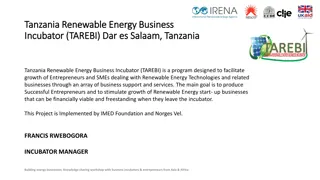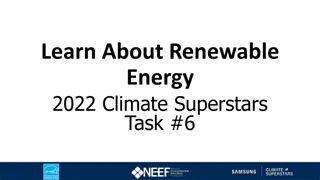Challenges in Integrating Renewable Energy in Pacific Islands Grids
Integrating renewable energy sources like solar, wind, wave, and tidal power into Pacific Islands grids presents challenges due to the variability and rates of change in power output. Solar energy, for example, is only available at certain times, and the load patterns need to be carefully considered for effective integration. Despite the challenges, there is a push towards utilizing renewable energy to reduce dependence on traditional sources.
Download Presentation

Please find below an Image/Link to download the presentation.
The content on the website is provided AS IS for your information and personal use only. It may not be sold, licensed, or shared on other websites without obtaining consent from the author.If you encounter any issues during the download, it is possible that the publisher has removed the file from their server.
You are allowed to download the files provided on this website for personal or commercial use, subject to the condition that they are used lawfully. All files are the property of their respective owners.
The content on the website is provided AS IS for your information and personal use only. It may not be sold, licensed, or shared on other websites without obtaining consent from the author.
E N D
Presentation Transcript
Challenges for Renewable Energy Integration in the Pacific Islands Grids Herb Wade
Why are There Challenges? Actually there are no serious challenges integrating most renewable energy generators into a grid as they just represent a different type of ordinary generating plant Hydro Geothermal Biomass Biofuel Biogas
The problem is the variability of some sources Variable inputs are provided by Solar Wind Wave Tidal
But the main problem is not just variability Problem with rates of change of power output Engines have to keep up with the change Fastest changes are with wind in stormy weather Solar can change 80% in a few seconds Wave more slowly Tidal, very slow And predictable
Integrating Solar Because solar only is available at high levels between about 0900 and 1500, the load at that time is the only one that is relevant with regards to solar design and integration unless there is substantial storage installed. Generally, use the noon-time load as the guiding parameter because that is when the solar is the strongest and there is the greatest possible change of output if clouds come by.
What solar enthusiasts want you to think solar input is like A clear day in the desert .. 6
Solar generation in real life A clear day in the Pacific
Also of concern is the pattern of the load .. 9
Noon time peak load urban grid Good for grid-connected solar input Typical of larger urban utilities Solar helps offset the peak Often peak is air conditioning which is also dependent on solar input
Evening Peak non-urban grid Not so good for grid connected solar Typical of small utilities with no major urban base Can only provide a small benefit because the solar does not arrive when the load needs it
Rule of Thumb for Solar Once you see the noon-time peak for solar reaches 20% of the noon-time load, there need to be concerns though instability may not occur until 50% or more if the solar is widely dispersed.. Don t forget noon time peaks are usually related to A/C use so Saturdays and Sundays may have a much lower noon-time load. Blue graph = weekday load and red graph = Sunday load which is typical of non-urban loads because the government and many business offices are closed and their A/C is off
Increasing penetration What happens when you go over the limit? It is much like a very large load going on and off when a cloud goes by So to make it possible to go higher, split the solar generation into several parts and spread it around the island so it all does not change at the same time.
Single large solar installation for Rarotonga
Then what 40% penetration of the noon load or even somewhat more can probably be achieved without significant problem with dispersed solar but to go much higher, energy storage and controls to help slow down and/or lower the extent of variations may be needed. Storage Options include Pumped storage (existing hydro is interesting) Batteries (the most common but rather expensive approach) Flywheels (not a major contender) Compressed air (requires special conditions not found in most of the Pacific)
How to predict what can reasonably be accepted? By using a dynamic model of the grid and trying different types of solar inputs in the model and different loading conditions to see the predicted results Model must be validated for the type of grid in use (mostly diesel in the Pacific)
